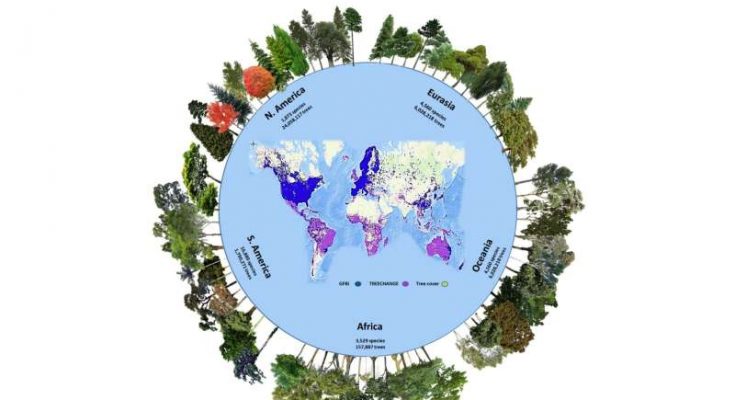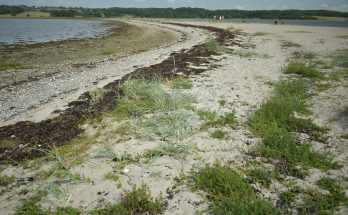#MichiganUniversity; #EarthScience; #TreeSpeciesOnEarth
CMEDIA: A new study involving more than 100 scientists from across the globe and the largest forest database yet assembled estimates that there are about 73,000 tree species on Earth, including about 9,200 species yet to be discovered.
The global estimate is about 14% higher than the current number of known tree species. Most of the undiscovered species are likely to be rare, with very low populations and limited spatial distribution, the study shows.
That makes the undiscovered species especially vulnerable to human-caused disruptions such as deforestation and climate change, according to the study authors, who say the new findings will help prioritize forest conservation efforts.
“These results highlight the vulnerability of global forest biodiversity to anthropogenic changes, particularly land use and climate because the survival of rare taxa is disproportionately threatened by these pressures,” said University of Michigan forest ecologist Peter Reich, one of two senior authors of a paper scheduled for publication Jan. 31 in Proceedings of the National Academy of Sciences.
“By establishing a quantitative benchmark, this study could contribute to tree and forest conservation efforts and the future discovery of new trees and associated species in certain parts of the world,” said Reich, director of the Institute for Global Change Biology at U-M’s School for Environment and Sustainability.
For the study, the researchers combined tree abundance and occurrence data from two global datasets—one from the Global Forest Biodiversity Initiative and the other from TREECHANGE—that use ground-source forest-plot data. The combined databases yielded a total of 64,100 documented tree species worldwide, a total similar to a previous study that found about 60,000 tree species on the planet.
“We combined individual datasets into one massive global dataset of tree-level data,” said the study’s other senior author, Jingjing Liang of Purdue University, coordinator of the Global Forest Biodiversity Initiative.
“Each set comes from someone going out to a forest stand and measuring every single tree—collecting information about the tree species, sizes and other characteristics. Counting the number of tree species worldwide is like a puzzle with pieces spread all over the world.”
After combining the datasets, the researchers used novel statistical methods to estimate the total number of unique tree species at biome, continental and global scales—including species yet to be discovered and described by scientists. A biome is a major ecological community type, such as a tropical rainforest, a boreal forest or a savanna.
Their conservative estimate of the total number of tree species on Earth is 73,274, which means there are likely about 9,200 tree species yet to be discovered, according to the researchers, who say their new study uses a vastly more extensive dataset and more advanced statistical methods than previous attempts to estimate the planet’s tree diversity. The researchers used modern developments of techniques first devised by mathematician Alan Turing during World War II to crack the Nazi code, Reich said.
Roughly 40% of the undiscovered tree species—more than on any other continent—are likely to be in South America, which is mentioned repeatedly in the study as being of special significance for global tree diversity.
South America is also the continent with the highest estimated number of rare tree species (about 8,200) and the highest estimated percentage (49%) of continentally endemic tree species—meaning species found only on that continent.
Hot spots of undiscovered South American tree species likely include the tropical and subtropical moist forests of the Amazon basin, as well as Andean forests at elevations between 1,000 meters (about 3,300 feet) and 3,500 meters (about 11,480 feet).
“Beyond the 27,000 known tree species in South America, there might be as many as another 4,000 species yet to be discovered there. Most of them could be endemic and located in diverse hot spots of the Amazon basin and the Andes-Amazon interface,” said Reich, who was recruited by U-M’s Biosciences Initiative and joined the faculty last fall from the University of Minnesota, where he maintains a dual appointment.
“This makes forest conservation of paramount priority in South America, especially considering the current tropical forest crisis from anthropogenic impacts such as deforestation, fires, and climate change,” he said.
Worldwide, roughly half to two-thirds of all already known tree species occur in tropical and subtropical moist forests, which are both species-rich and poorly studied by scientists. Tropical and subtropical dry forests likely hold high numbers of undiscovered tree species, as well.
“Extensive knowledge of tree richness and diversity is key to preserving the stability and functioning of ecosystems,” said study lead author Roberto Cazzolla Gatti of the University of Bologna in Italy.
Forests provide many “ecosystem services” to humanity for free. In addition to supplying timber, fuelwood, fiber, and other products, forests clean the air, filter the water, and help control erosion and flooding. They help preserve biodiversity, store climate-warming carbon, and promote soil formation and nutrient cycling while offering recreational opportunities such as hiking, camping, fishing, and hunting.
More than 100 scientists from research groups around the world are co-authors of the PNAS study.





